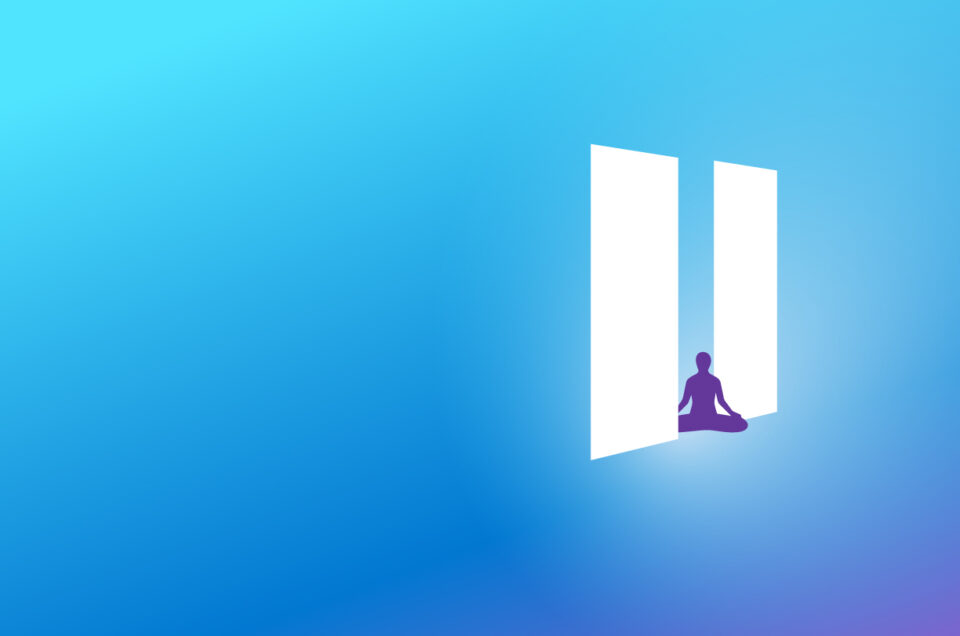Research Proves Your Brain Needs Breaks

New options help you carve out downtime between meetings
For many people, back-to-back video meetings are a hallmark of the pandemic era. One conversation ends, another begins, and too often there’s no chance to stretch, pour a glass of water, or just clear your head.
In our latest study of brain wave activity, researchers confirmed what many people sense from experience: Back-to-back virtual meetings are stressful. But the research also points to a simple remedy—short breaks.
“Our research shows breaks are important, not just to make us less exhausted by the end of the day, but to actually improve our ability to focus and engage while in those meetings,” says Michael Bohan, senior director of Microsoft’s Human Factors Engineering group, who oversaw the project.
Settings in Microsoft Outlook make it easier and automatic to carve out these essential breaks between back-to-backs—and because we know that one size does not fit all, companies have two options. Individuals can set scheduling defaults that automatically shorten meetings they schedule. And now customers have the ability to set organization-wide scheduling defaults that shorten meetings and create space for breaks for everyone at the company.
“The back-to-back meetings that have become the norm over the last 12 months just aren’t sustainable,” says Jared Spataro, CVP, Microsoft 365. “Outlook and Microsoft Teams are used by millions of people around the world, and this small change can help customers develop new cultural norms and improve wellbeing for everyone.”
“In today’s world of remote and hybrid work, it’s not sufficient to only encourage self-care. We need to innovate and leverage technology to help employees operationalize much-needed breaks into their daily routines.”
Here at Microsoft, because we have many employees in different functions around the world, we’re encouraging individuals to turn on the setting if it works for them and their team. And as we shift into hybrid work, we’ll continue to learn and look for ways to improve the way we work together in this new, more digital world.
The case for breaks: what the research says
As the pandemic upended routines and heightened the digital intensity of workdays, hundreds of researchers across Microsoft came together to study how work is changing, amassing one of the world’s largest bodies of research on the subject.
Our most recent study builds on that work. Microsoft’s Human Factors Lab sought to find a solution for meeting fatigue—a pressing concern in our new era of remote and hybrid work. Researchers from the lab, which examines how humans interact with technology, asked 14 people to take part in video meetings while wearing electroencephalogram (EEG) equipment—a cap to monitor the electrical activity in their brains.
The 14 volunteers each participated in two different sessions of meetings. On one day they attended stretches of four half-hour meetings back-to-back, with each call devoted to different tasks—designing an office layout, for example, or creating a marketing plan. On another day, the four half-hour meetings were interspersed with 10-minute breaks. Instead of hurriedly jumping from one meeting to the next, participants meditated with the Headspace app during the breaks.
To ensure clean data, all the participants taking breaks were assigned the same downtime activity—in this case meditation—so the results would be comparable. The sessions took place on two consecutive Mondays; some participants started with back-to-backs while the others had breaks between meetings, and the next week they switched. We also had additional people join meetings with the research subjects to simulate a typical day interacting with various teams.
The research showed three main takeaways.
1. Breaks between meetings allow the brain to “reset,” reducing a cumulative buildup of stress across meetings.
As we’ve seen in previous studies, in two straight hours of back-to-back meetings, the average activity of beta waves—those associated with stress—increased over time. In other words, the stress kept accumulating.
But when participants were given a chance to rest using meditation, beta activity dropped, allowing for a “reset.” This reset meant participants started their next meeting in a more relaxed state. It also meant the average level of beta waves held steady through four meetings, with no buildup of stress even as four video calls continued.
The antidote to meeting fatigue is simple: taking short breaks.
Your brain works differently when you take breaks
Taking time out between video calls prevents stress from building up.
Microsoft’s Human Factors Lab used EEG caps to measure beta wave activity—associated with stress—in the brains of meeting participants. For those given breaks, their average beta wave activity remained largely steady over time; the “coolness” of their stress levels is visualized here in blues and greens. For those deprived of breaks, their average beta wave activity rose as time passed, suggesting a buildup of stress; that increase is depicted here with colors shifting from cool to hot. The chart represents the relative difference in beta activity between break and no-break conditions at the top of each meeting (averaged across the 14 research participants).
2. Back-to-back meetings can decrease your ability to focus and engage.
When participants had meditation breaks, brainwave patterns showed positive levels of frontal alpha asymmetry, which correlates to higher engagement during the meeting. Without breaks, the levels were negative, suggesting the participants were withdrawn, or less engaged in the meeting. This shows that when the brain is experiencing stress, it’s harder to stay focused and engaged.
In sum, breaks are not only good for wellbeing, they also improve our ability to do our best work.
Taking breaks helps you engage better
Breathers don’t just alleviate stress, they help your performance.

To gauge whether people are engaged or withdrawn, researchers study a brainwave pattern known as frontal alpha asymmetry (the difference between right and left alpha wave activity in the frontal area of the brain). In Microsoft’s study, those taking breaks showed positive asymmetry, which is associated with higher engagement. Those who didn’t take breaks showed negative asymmetry, which is associated with being more withdrawn.
Illustration by Valerio Pellegrini
3. Transitioning between meetings can be a source of high stress.
For the participants deprived of breaks, researchers also noticed that the transition period between calls caused beta activity, or stress levels, to spike.
That might be because “you’re coming to the end of the meeting, knowing you have another one coming right up, and you’re going to have to switch gears and use your brain to think hard about something else,” Bohan says.
For those participants, beta wave activity jumped again when new check ins started. When people took meditation breaks, by contrast, the increase in beta activity dropped between meetings, and the increase at the start of the next meeting was much gentler and smoother.
Jumping directly from one meeting to another can cause spikes of stress
Taking breaks between conversations eases that stress.
Without breaks, beta wave activity in the brain can rise sharply at the beginning and end of meetings, suggesting heightened stress. Taking breaks not only prevents those spikes but causes a dip in beta activity—which correlates with less stress.
The takeaway: Breaks, even short ones, are important to make the transitions between meetings feel less stressful.
“What makes this study so powerful and relatable is that we’re effectively visualizing for people what they experience phenomenologically inside,” Bohan says. “It’s not an abstraction—quite the opposite. It’s a scientific expression of the stress and fatigue people feel during back-to-backs.”
How we are adapting our products—and practices
These findings helped inform settings in Outlook that allow individuals or organizations to set defaults that shave five, 10, or 15 minutes off Microsoft Teams meetings to carve out breaks between conversations.
For example, an individual or company might decide to start its meetings five minutes after the hour or half-hour, so that 30-minute check ins drop to 25 minutes and hour-long conversations shorten to 55 minutes. That means a half-hour meeting that would have started at 11 a.m. will become a 25-minute meeting beginning at 11:05 a.m.
It’s not just the brain research that supports this change. Digital overload has become an urgent issue in the new era of remote and hybrid work. In Microsoft’s 2021 Work Trend Index published in March, 54 percent of respondents in a global external survey said they feel overworked, while 39 percent described themselves as outright exhausted.
Over the past year, we have introduced several new capabilities to foster wellbeing in this time of rapid change. Together mode in Microsoft Teams helps combat meeting fatigue; a virtual commute helps reestablish boundaries between work and home; and a Headspace integration coming with the Microsoft Viva Insights app promotes mindfulness. This new Outlook setting is a next step in this wellbeing journey, with more to come.
One final note: If you’re using the new setting in Outlook to build in break times between meetings, consider stepping away from your computer. “Try not to use that five or 10 minutes to squeeze in some other kind of work,” Bohan says. “Catch your breath and take a break away from your screen.”
Strategies for making breaks successful—and beating meeting fatigue
Because we know making space for breaks is easier said than done, we’ve pulled together some research-backed tips on carving out time to pause, getting the most from moments of respite, and making meetings more effective and energizing.
Shift your mindset. While it might feel more productive to power through back-to-backs, research shows the opposite is true. View breaks away from your computer as an essential part of your workday.
Find break activities that calm your mind. Meditation is one effective way to relax and recharge between meetings, but other studies show that physical activity such as walking is also beneficial. Past Microsoft studies suggest that doodling or reading something enjoyable also bring benefits. “It can be anything that takes your mind away from work-related things and focuses it on something that you feel is relaxing,” Bohan says. That will help you be refreshed and recharged when you start your next meeting.
Create even more time for breaks by considering other modes of communication. Before scheduling a video call, pause and ask yourself: Do we really need a meeting on this issue? More dynamic, creative, or emotional topics may require a meeting, while status check ins and informational subjects may benefit from document collaboration, a Teams channel, or email. Other simple tasks may be handled via chat. Learn more.
Make meetings more intentional. The best—and often shortest—meetings are more intentional. Best practices like creating and sending an agenda ahead of time, being thoughtful about who attends, starting and stopping on time, and transitioning to a recap for the final five minutes will make it easier to accomplish your goals in less time. Learn more.
Keep participants engaged and energized. In virtual meetings, it can be hard to chime in remotely. A moderator can help ensure remote participants are included. Features like Raise your hand, Whiteboard, and Breakout Rooms in Microsoft Teams are great ways to use technology to elicit creative and strategic conversations.
Source: Microsoft

